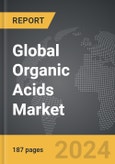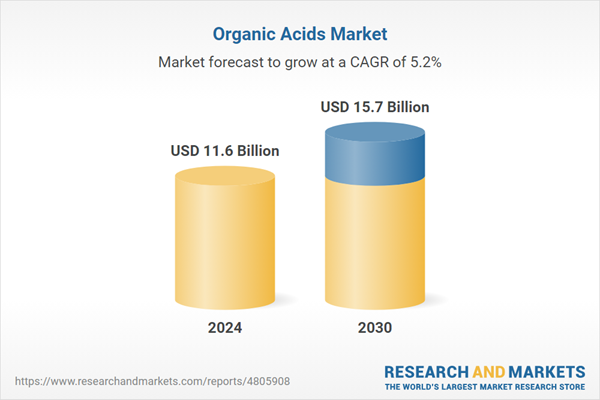The global market for Organic Acids was valued at USD 11.6 Billion in 2024 and is projected to reach USD 15.7 Billion by 2030, growing at a CAGR of 5.2% from 2024 to 2030. This comprehensive report provides an in-depth analysis of market trends, drivers, and forecasts, helping you make informed business decisions.
Global Organic Acids Market - Key Trends & Drivers Summarized
What Are Organic Acids, and Why Are They Important?
Organic acids are naturally occurring compounds that contain one or more carboxyl groups (-COOH) and are primarily used in various industrial, agricultural, and food applications. They include a wide range of acids such as citric acid, acetic acid, lactic acid, and formic acid, which are derived from natural sources or synthesized through microbial fermentation. Organic acids play a crucial role as preservatives, flavoring agents, pH regulators, and antimicrobial agents, making them indispensable in the food and beverage industry. Beyond food, they are used in animal feed, pharmaceuticals, and biodegradable plastics. As the global market shifts towards more sustainable and eco-friendly solutions, organic acids are increasingly preferred due to their natural origins and lower environmental impact compared to synthetic acids.How Are Technological Innovations Shaping the Organic Acids Market?
The production of organic acids has seen significant technological advancements, particularly through biotechnological processes such as microbial fermentation. Innovations in fermentation technology, especially the use of genetically engineered microorganisms, have dramatically increased the efficiency and yield of organic acid production. These biotechnological methods allow for the production of high-purity acids at lower costs, meeting the growing demand for natural and sustainable products across multiple industries. Another key trend is the development of bio-based organic acids, which are produced from renewable resources like biomass, further aligning with the push towards green chemistry and sustainability. Moreover, continuous improvements in downstream processing techniques, such as membrane separation and crystallization, have enhanced the quality and purity of organic acids, making them suitable for a broader range of applications in food, pharmaceuticals, and industrial chemicals.Where Are Organic Acids Most Widely Used?
The primary applications of organic acids are in the food and beverage, pharmaceutical, and agricultural industries, with their usage expanding into other sectors such as chemicals and cosmetics. In the food and beverage industry, organic acids are vital as preservatives and acidity regulators in products like soft drinks, jams, sauces, and dairy products. Citric acid, for instance, is one of the most commonly used additives in beverages, while lactic acid is frequently used in dairy fermentation. The pharmaceutical industry uses organic acids in the formulation of various medications and as excipients in drug delivery systems. In agriculture, organic acids like formic acid are utilized in animal feed to improve nutrient absorption and as an alternative to synthetic growth promoters. Their antimicrobial properties also make them useful in protecting crops and enhancing soil health. Additionally, organic acids are increasingly finding applications in the production of bio-based plastics and biodegradable packaging materials, driving their use in the broader industrial sector.What Is Driving the Growth of the Organic Acids Market?
The growth in the organic acids market is driven by several factors reflecting industry-wide shifts toward sustainability and natural ingredients. One of the key drivers is the increasing consumer demand for natural food additives and preservatives, as health-conscious consumers seek alternatives to synthetic chemicals in their diets. This trend is especially strong in the food and beverage industry, where organic acids like citric and acetic acids are used to extend shelf life and enhance flavor. Another important factor is the growing demand for bio-based chemicals in industrial applications, particularly in biodegradable plastics, which are viewed as more environmentally friendly alternatives to petrochemical-based products. The animal feed industry is also contributing to market growth, as organic acids are increasingly used to improve gut health in livestock, reduce antibiotic use, and promote sustainable farming practices. Additionally, advancements in biotechnological production methods are making organic acids more accessible and cost-effective, further boosting their adoption across various industries. Finally, stringent environmental regulations and the push for eco-friendly chemical processes are propelling the use of organic acids, particularly in industrial sectors that seek to reduce their carbon footprint and environmental impact.Report Scope
The report analyzes the Organic Acids market, presented in terms of market value (USD Thousand). The analysis covers the key segments and geographic regions outlined below.Segments
Type (Acetic Acid, Formic Acid, Citric Acid, Lactic Acid, Fumaric Acid, Propionic Acid, Other Types); Application (Food & Beverage, Pharmaceuticals, Feed, Industrial, Other Applications).Geographic Regions/Countries
World; United States; Canada; Japan; China; Europe (France; Germany; Italy; United Kingdom; Spain; Russia; and Rest of Europe); Asia-Pacific (Australia; India; South Korea; and Rest of Asia-Pacific); Latin America (Argentina; Brazil; Mexico; and Rest of Latin America); Middle East (Iran; Israel; Saudi Arabia; United Arab Emirates; and Rest of Middle East); and Africa.Key Insights:
- Market Growth: Understand the significant growth trajectory of the Acetic Acid segment, which is expected to reach $4.6 Billion by 2030 with a CAGR of a 5.6%. The Formic Acid segment is also set to grow at 4.9% CAGR over the analysis period.
- Regional Analysis: Gain insights into the U.S. market, valued at $3.1 Billion in 2024, and China, forecasted to grow at an impressive 8.4% CAGR to reach $3.5 Billion by 2030. Discover growth trends in other key regions, including Japan, Canada, Germany, and the Asia-Pacific.
Report Features:
- Comprehensive Market Data: Independent analysis of annual sales and market forecasts in USD from 2024 to 2030.
- In-Depth Regional Analysis: Detailed insights into key markets, including the U.S., China, Japan, Canada, Europe, Asia-Pacific, Latin America, Middle East, and Africa.
- Company Profiles: Coverage of major players such as Archer Daniels Midland Company, BASF SE, Cargill, Inc., Corbion NV, Dow, Inc. and more.
- Complimentary Updates: Receive free report updates for one year to keep you informed of the latest market developments.
Why You Should Buy This Report:
- Detailed Market Analysis: Access a thorough analysis of the Global Organic Acids Market, covering all major geographic regions and market segments.
- Competitive Insights: Get an overview of the competitive landscape, including the market presence of major players across different geographies.
- Future Trends and Drivers: Understand the key trends and drivers shaping the future of the Global Organic Acids Market.
- Actionable Insights: Benefit from actionable insights that can help you identify new revenue opportunities and make strategic business decisions.
Key Questions Answered:
- How is the Global Organic Acids Market expected to evolve by 2030?
- What are the main drivers and restraints affecting the market?
- Which market segments will grow the most over the forecast period?
- How will market shares for different regions and segments change by 2030?
- Who are the leading players in the market, and what are their prospects?
Some of the 28 major companies featured in this Organic Acids market report include:
- Archer Daniels Midland Company
- BASF SE
- Cargill, Inc.
- Corbion NV
- Dow, Inc.
- DuPont de Nemours, Inc.
- Dow, Inc.
- DuPont de Nemours, Inc.
- Eastman Chemical Company
- Henan Jindan Lactic Acid Technology Co., Ltd.
- Koninklijke DSM NV
- Myriant Corporation
- Tate & Lyle PLC
Table of Contents
I. METHODOLOGYII. EXECUTIVE SUMMARY2. FOCUS ON SELECT PLAYERSIII. MARKET ANALYSISCANADAITALYSPAINRUSSIAREST OF EUROPESOUTH KOREAREST OF ASIA-PACIFICARGENTINABRAZILMEXICOREST OF LATIN AMERICAIRANISRAELSAUDI ARABIAUNITED ARAB EMIRATESREST OF MIDDLE EASTIV. COMPETITION
1. MARKET OVERVIEW
3. MARKET TRENDS & DRIVERS
4. GLOBAL MARKET PERSPECTIVE
UNITED STATES
JAPAN
CHINA
EUROPE
FRANCE
GERMANY
UNITED KINGDOM
ASIA-PACIFIC
AUSTRALIA
INDIA
LATIN AMERICA
MIDDLE EAST
AFRICA
Companies Mentioned (Partial List)
A selection of companies mentioned in this report includes, but is not limited to:
- Archer Daniels Midland Company
- BASF SE
- Cargill, Inc.
- Corbion NV
- Dow, Inc.
- DuPont de Nemours, Inc.
- Dow, Inc.
- DuPont de Nemours, Inc.
- Eastman Chemical Company
- Henan Jindan Lactic Acid Technology Co., Ltd.
- Koninklijke DSM NV
- Myriant Corporation
- Tate & Lyle PLC
Table Information
| Report Attribute | Details |
|---|---|
| No. of Pages | 187 |
| Published | April 2025 |
| Forecast Period | 2024 - 2030 |
| Estimated Market Value ( USD | $ 11.6 Billion |
| Forecasted Market Value ( USD | $ 15.7 Billion |
| Compound Annual Growth Rate | 5.2% |
| Regions Covered | Global |









